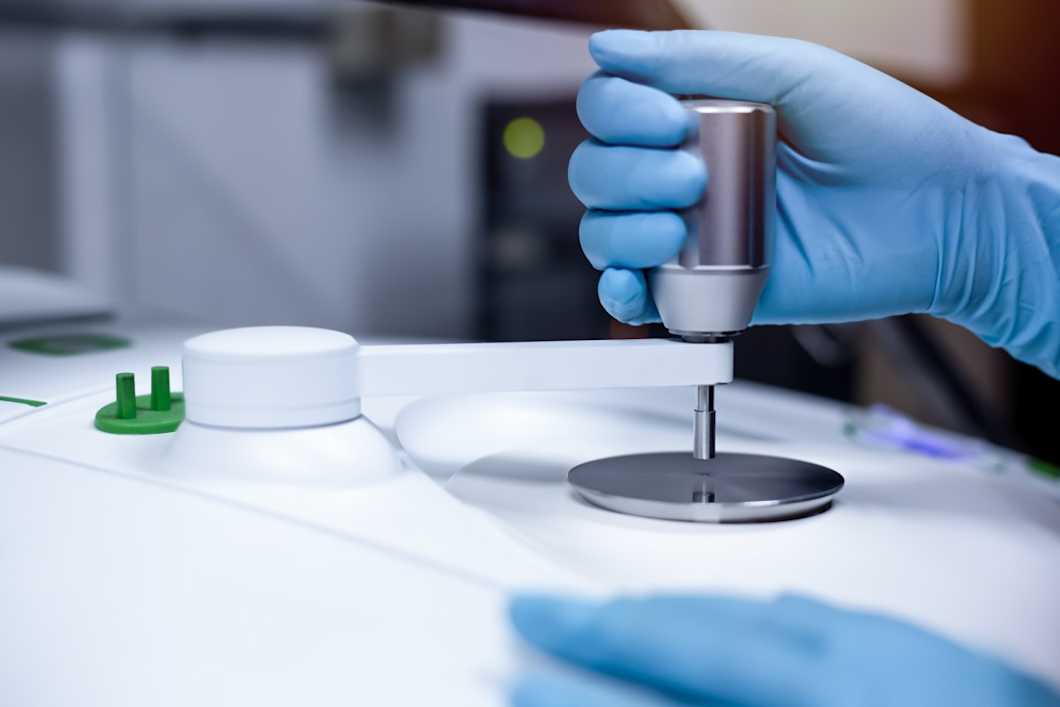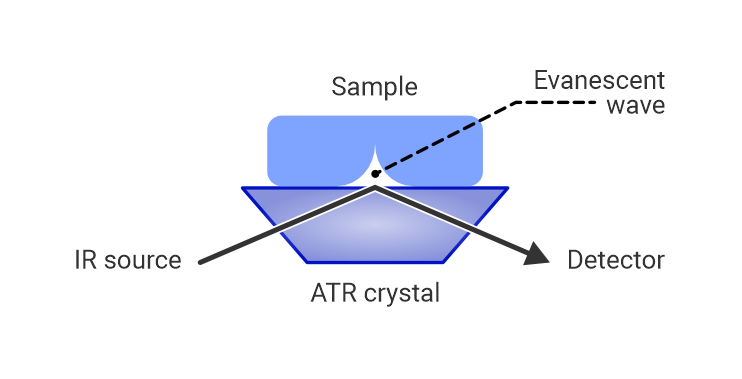ATR-FTIR analysis
Attenuated total reflectance (ATR) is a popular FTIR spectroscopy sampling technique that enables fast characterization of various sample types with minimal preparation. ATR-FITR is utilized widely in industries including polymers, pharmaceuticals, food, and fuels.

What is ATR-FTIR used for?
ATR-FTIR is used in various research areas and industries. Examples of applications include material identification in the plastics industry, pharmaceutical industry quality control, and protein analysis in biological research. The method is also used for chemical characterization in industries including consumer goods, food, fuels, and biorefinery.
One increasingly popular application of ATR-FTIR is identifying microplastics released from textiles during laundering. The analysis can be supplemented with the SEM-EDX method to obtain further information on the identified particles.
How does attenuated total reflection work?
The ATR-FTIR apparatus consists of an infrared light source, a detector, and a crystal with a high refractive index, such as diamond, germanium, or zinc selenide. The sample is placed on the crystal and infrared light is directed at it. The light passes through the crystal and reflects at the crystal-sample interface, where it partially penetrates the sample, creating an evanescent wave.
Some of the light is absorbed within the evanescent wave, which means that the reflected light now carries information about how the sample absorbs IR radiation. The reflected light passes to the detector, allowing an FTIR-ATR spectrum to be produced. When compared with a library of known spectra, the obtained spectrum can help identify the sample's chemical composition.

The advantages of ATR in FTIR sampling
ATR allows for various sample types, including liquids, solids, powders, and solutions, to be tested whilst yielding consistent, reproducible results. It generally requires very little sample preparation compared with other forms of FTIR and only requires a small amount of sample to produce high-quality results. In most cases, the sample can be recovered after analysis.
Single-reflection vs. multi-reflection ATR sensors
In single-reflection ATR-FTIR analysis, the infrared light is reflected from the surface boundary a single time before being detected. Multi-reflection ATR sensors have a larger crystal which allows the light to reflect multiple times before being detected. The benefit is increased sensitivity for particularly weak absorbances, making multi-reflection sensors ideal for harder-to-detect chemical groups and for testing low-concentration solutions.
Need ATR-FTIR analyses?
Measurlabs offers laboratory testing with ATR-FTIR and conventional FTIR methods. From tens to hundreds of samples, we ensure your analyses are handled on time, with the highest quality. Should you need assistance with method selection, our testing experts are always here to help craft testing plans and offer their best recommendations. More than 700 companies choose Measurlabs for accurate results and dependable expert service - contact us through the form below to get a quote and experience our service level yourself.
Suitable sample matrices
- Powders
- Solid objects
- Liquids
- Solutions
Ideal uses of FTIR-ATR
- Identification of unknown compounds
- Quality control of consumer goods
- Biological research
- Microplastic identification
Ask for an offer
Fill in the form, and we'll reply in one business day.
Have questions or need help? Email us at info@measurlabs.com or call our sales team.
Frequently asked questions
ATR-FTIR can be used to analyze the chemical composition of solid and liquid sample materials, including polymers, pharmaceuticals, fuels, and food.
The ATR-FTIR setup yields consistent, reliable, and comparable results quickly with little to no sample preparation.
Measurlabs offers a variety of laboratory analyses for product developers and quality managers. We perform some of the analyses in our own lab, but mostly we outsource them to carefully selected partner laboratories. This way we can send each sample to the lab that is best suited for the purpose, and offer high-quality analyses with more than a thousand different methods to our clients.
When you contact us through our contact form or by email, one of our specialists will take ownership of your case and answer your query. You get an offer with all the necessary details about the analysis, and can send your samples to the indicated address. We will then take care of sending your samples to the correct laboratories and write a clear report on the results for you.
Samples are usually delivered to our laboratory via courier. Contact us for further details before sending samples.